From Manual to Automated Testing: A Comprehensive Overview to Transitioning Smoothly and Efficiently
In the realm of software program testing, the change from handbook to automated procedures has come to be a progressively vital shift for organizations looking for to boost performance and accuracy in their screening methods. The trip from manual to automated screening is not without its challenges, however when come close to tactically and with a clear strategy in mind, the benefits can be substantial.
Benefits of Automated Examining
Automated screening supplies many benefits, boosting effectiveness and precision in software advancement procedures. One main benefit is the considerable decrease in testing time. Automated tests can be run at the same time on numerous devices and operating systems, substantially speeding up the screening stage contrasted to hand-operated screening. This raised effectiveness enables faster responses on the top quality of the software application, enabling developers to recognize and attend to issues immediately.
In addition, automated screening guarantees a higher degree of accuracy in spotting issues. Uniformity in testing is additionally boosted, as automated tests execute the very same actions precisely each time they are run.
Picking the Right Tools

To start with, analyze your goals and demands. Comprehend the range of your project, the technologies entailed, and the capability of your team. This evaluation will aid you identify the abilities and functions you require in your screening tools.
Secondly, consider the compatibility of the tools with your existing systems and procedures. Seamless assimilation with your present software application growth lifecycle is necessary to ensure a smooth change to automation.
Additionally, assess the scalability and versatility of the devices. As your testing requires progress, the devices ought to be able to adapt and accommodate adjustments effectively.
Finally, consider the assistance and community around the tools. Durable support and an active individual community can offer beneficial sources and help when carrying out automated testing. By carefully thinking about these aspects, you can choose the right devices that align with your demands and established the stage for an effective change to automated testing.
Writing Efficient Examination Manuscripts

When crafting examination scripts, it is important to think about the specific demands of the software being examined and guarantee that the manuscripts deal with all critical performances. Descriptive and clear calling conventions for test scripts and examination cases can improve readability and maintainability. In addition, integrating mistake handling mechanisms within the examination manuscripts can help in determining and addressing problems immediately.
Furthermore, organizing examination manuscripts into modular elements can enhance reusability and scalability, reducing redundancy and boosting efficiency in test manuscript upkeep. Regular evaluations and updates to examine manuscripts are essential to equal evolving software application demands and capabilities. By complying with these concepts, testers can develop efficient and robust examination manuscripts that add significantly to the success of automated testing processes.
Integrating Automation Into Workflows
By effortlessly integrating automated screening tools like Selenium or Appium right into the software growth lifecycle, teams can attain faster feedback on code adjustments, leading to quicker bug discovery and resolution. This combination permits for constant screening throughout the development procedure, ensuring that any type of concerns are determined early on, resulting in greater software high quality. Correct integration of automation devices calls for partnership in between development, testing, and procedures teams to establish a unified process that maximizes efficiency and efficiency in delivering top notch software products.
Making Sure a Smooth Transition
Effectively transitioning to automated screening entails meticulous planning and cautious implementation to minimize interruptions and make the most of effectiveness in the software application growth process - automation testing. To guarantee a smooth shift, it is necessary to begin by conducting an extensive evaluation of the existing screening procedures and recognizing locations where automation can bring one of the most substantial advantages. Involving with all stakeholders beforehand in the process, including designers, testers, and job managers, is vital for gathering assistance and buy-in for the automation effort
Interaction is crucial throughout this change stage. Clear interaction of the objectives, benefits, and expectations of automated testing helps to manage any kind of resistance or problems that might develop. Furthermore, offering sufficient training and resources for group participants to upskill in automation devices and methods is important for guaranteeing a successful change.

Final Thought
Finally, transitioning address from manual to automated testing provides many advantages, consisting of boosted performance and integrity. By picking the ideal devices, creating reliable examination manuscripts, and you could try this out incorporating automation flawlessly right into operations, companies can ensure a successful and smooth change. It is necessary to embrace automation as an important asset in software screening procedures to enhance general high quality and productivity.
In the realm of software program screening, the change from handbook to automated processes has actually come to be a significantly crucial shift for organizations looking for to boost effectiveness and accuracy in their testing techniques. Automated examinations can be run all at once on several devices and running systems, substantially speeding up the screening phase compared to hand-operated testing. Consistency in screening is likewise improved, as automated examinations carry out the same actions exactly each time they are run.To guarantee the effective application of selected screening devices, the creation of effective examination scripts plays a crucial duty in verifying the functionality and efficiency of automated processes - automation testing. By adhering to these find more information principles, testers can develop robust and reliable test manuscripts that contribute dramatically to the success of automated screening processes